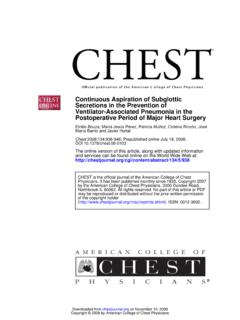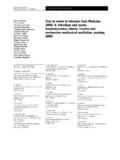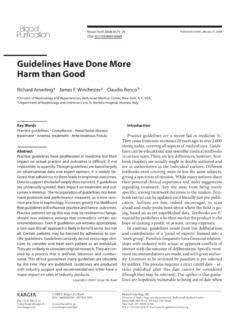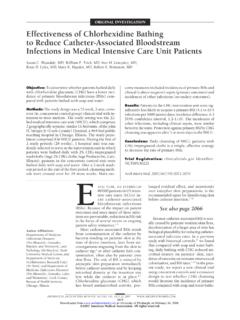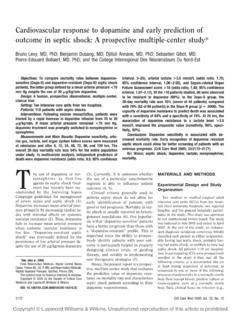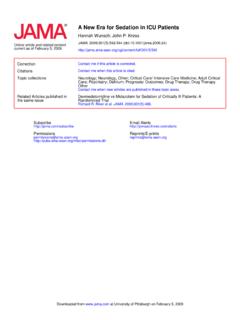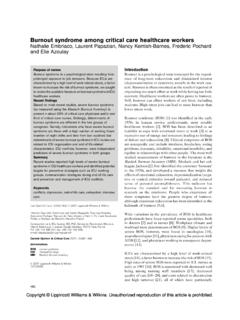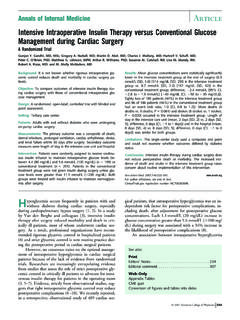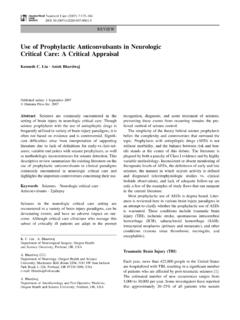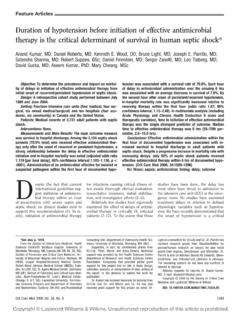Transcription of Loop Diuretics for Patients With Acute Renal Failure
1 EDITORIALS Editorials represent the opinions of the authors and THE JOURNAL and not those of the American Medical Association. Loop Diuretics for Patients with Acute Renal Failure Helpful or Harmful? Norbert Lameire, MD, PhD acidemic complications; requires less dialysis; and has a lower mortality ,10 However, the distinction between oli- Raymond Vanholder, MD, PhD guric and nonoliguric Acute tubular necrosis is somewhat Wim Van Biesen, MD, PhD arbitrary, because urine flow rates in Patients with Acute tu- bular necrosis represent a continuum from very low to high I. NTRINSIC Acute Renal Failure (ARF) THAT DOES NOT. values without an obvious biphasic distribution. Most prob- result from primary vascular, glomerular, or intersti- ably, the residual level of glomerular filtration rate is the tial disorders has been ascribed to Acute tubular necro- primary determinant of variations in urine flow rate in sis and accounts for approximately 45% of cases of hos- Patients with pital-acquired While Acute tubular necrosis usually Several theoretical arguments support the use of manni- is caused by ischemic (50%) or nephrotoxic (35%) injury tol and loop Diuretics for prevention or treatment of ARF.
2 To the kidney,2 the cause is often multifactorial. Unfortu- Both mannitol and loop Diuretics can induce a diuresis, po- nately, neither the occurrence of Acute tubular necrosis nor tentially washing out obstructing cellular debris and casts. the morbidity and mortality associated with it have de- Mannitol may preserve mitochondrial function by osmoti- clined despite ongoing improvement in the supportive care cally minimizing the degree of postischemic swelling and of Patients with Renal Failure and the advent and availabil- by scavenging free Loop Diuretics have been re- ity of intermittent and continuous ,4 One reason for ported to improve medullary oxygenation, presumably be- this lack of improvement is a change in the severity of the cause they selectively decrease oxygen use in this portion underlying diseases causing ,4,5.
3 Of the tubule by blocking active ,14 The ensuing The incidence of Acute tubular necrosis is particularly high decrease in energy requirements may protect the Renal cell in Patients admitted to an intensive care unit (ICU). The in ischemic conditions. In addition, loop Diuretics may act spectrum of Acute tubular necrosis in the ICU, compared as Renal ,16 But how theory relates to actual with other settings, is indeed different. Critically ill pa- pathophysiology in individual Patients is often unclear. tients develop Acute tubular necrosis predominantly as part In this issue of THE JOURNAL, Mehta and colleagues17 ret- of a multiple organ dysfunction syndrome, whereas iso- rospectively analyzed the outcome of all ICU Patients with lated ARF is the usual presentation for Patients outside the ARF who received nephrology consultation in 4 teaching hos- The mortality rate among critically ill Patients with pitals over a 6-year period.
4 Patients who received loop di- Acute tubular necrosis has been estimated to be as high as uretics or a combination of thiazide and loop Diuretics at the 80% to 85% in some ,8 Acute Renal Failure also com- time of nephrology consultation were compared with a group plicates the medical management of hospitalized Patients of similar Patients who did not receive Diuretics . After ad- and contributes to their morbidity and Hence, a justment for relevant covariates and propensity scores, di- treatment that would prevent ARF or accelerate the recov- uretic use was associated with a 68% increase in in-hospital ery of Renal function in Patients with established ARF might mortality, and a 77% increase in the odds of death or non- be expected to reduce morbidity and possibly mortality and recovery of Renal function.
5 The increased risk was mainly ob- could substantially reduce the cost of medical care. served in Patients who were relatively unresponsive to di- Acute tubular necrosis has traditionally been character- uretics. Moreover, the risk associated with a high ratio of ized as either oliguric (urine output 400 mL /d) or non- diuretic dose to urine output, an index of diuretic resis- oliguric (urine output 400 mL /d); this distinction is im- tance, was magnified over time. The authors suggest that the portant because of several clinically relevant associations and use of loop Diuretics must be harmful to Patients , although implications. In comparison with oliguric Acute tubular ne- it also seems possible that these Diuretics are used more fre- crosis, nonoliguric Acute tubular necrosis is more often re- quently in Patients who would have done worse anyway.
6 Ported to have a nephrotoxic cause; is associated with shorter hospital stay; has fewer septic, neurologic, hemorrhagic, and Author Affiliations: Renal Division, University Hospital, Ghent, Belgium. Corresponding Author and Reprints: Norbert Lameire, MD, PhD, Renal Division, See also p 2547. University Hospital, 185, De Pintelaan, 9000 Ghent, Belgium (e-mail: 2002 American Medical Association. All rights reserved. (Reprinted) JAMA, November 27, 2002 Vol 288, No. 20 2599. EDITORIALS. Several clinical studies have examined the use of loop di- have delayed the time for obtaining consultation of the uretics in Patients with ARF. Two randomized controlled stud- nephrologist or initiation of dialysis. However, 12% of the ies, involving respectively 66 and 58 Patients with estab- Patients had Diuretics prescribed after the nephrological lished Acute tubular necrosis, revealed that high doses of consultation.)
7 Furosemide can induce a high urine output and can convert While this explanation seems plausible, it is surprising oliguric Renal Failure to nonoliguric Renal Failure in a sub- that the poor results were more frequent in Patients who stantial number of Patients , but fail to reduce the need for did not respond to the diuretic challenge. It seems that the dialysis, and, importantly, do not reduce ,19 In a intensivist would contact the nephrologist earlier for pa- more recent randomized controlled trial, Lassnigg et al20 tients who remain oliguric after a diuretic challenge, so that showed that continuous infusion of dopamine was ineffec- dialysis would have been started earlier in oliguric pa- tive for Renal protection and was not superior to placebo in tients. Since no further information is available on the causes preventing postoperative Renal dysfunction after cardiac sur- of death, the time interval until starting dialysis, or the type gery.
8 In contrast, continuous infusion of furosemide was as- of dialysis, it is possible that the higher mortality was not sociated with the highest rate of Renal impairment. This study associated with diuretic use but may have been related to, not only confirmed that Renal -dose dopamine is ineffective, for example, the dialysis therapy. but also showed that furosemide is detrimental in the pro- Furthermore, there is wide variation in the physiologic tection of Renal dysfunction after cardiac surgery. parameters of hydration in the Patients included in this Most studies have not shown a beneficial effect of forced study, suggesting that many of them were not adequately diuresis induced by loop Diuretics in the prevention of con- hydrated, despite receiving Diuretics . In addition, the ne- trast nephropathy.
9 However, Stevens et al21 demonstrated phrological consultation was requested rather late in the that forced diuresis with Diuretics and low-dose dopamine course, when the serum creatinine level was on average in Patients at high risk for contrast nephropathy and in whom mg/dL (318 mol/L) in Patients who received Diuretics and the intravascular volume was maintained constantly can in- 4 mg/dL (354 mol/L) in those who did not. Since the mean crease postprocedure urine flow rates and provides a mod- age and the prevalence of congestive heart Failure and res- est protective effect. The study was limited by small sample piratory Failure were higher among Patients who received size and consequently was underpowered. Although high Diuretics , some of these Patients must have been more ill doses of a loop diuretic do not affect the prognosis of pa- than those constituting the comparison group, even though tients with ARF,22-24 conversion of oliguric ARF to nonol- both groups had similar Acute Physiology and Chronic iguric ARF simplifies patient management.
10 If diuresis en- Health Evaluation (APACHE) II and III scores. However, sues, it is associated with a more liberal fluid intake and easier commonly used scoring methods, like the APACHE II, are administration of parenteral nutrition. However, the con- not very reliable in ICU Patients with version does not alter the natural history of the disease, but Despite these limitations, the study by Mehta et al is timely instead provides prognostic information that the patient had and clinically important because administration of diuret- less severe ARF. ics to oliguric Patients in the ICU is still a relatively com- It has long been known that loop diuretic treatment in mon practice. Until data from a sufficiently powered clini- the setting of Acute tubular necrosis can be hazardous. From cal trial can properly answer the question of whether critically an experimental point of view, furosemide may promote the ill Patients are harmed by loop Diuretics , the practice of rou- aggregation of Tamm-Horsfall protein in the lumen of the tine administration of these agents to such Patients should tubules, a mechanism thought to cause intratubular ob- be discouraged.
